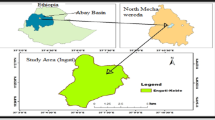Abstract
One of the objectives of the Irrigation Improvement Project (IIP) in the Nile Delta, Egypt, is to facilitate equitable water distribution and improve on-farm irrigation management by improving irrigation infrastructure. Because paddy rice is a major summer crop in Egypt and it consumes the greatest amount of water in comparison with other crops, the authors focused on monitoring and evaluating the irrigation practices of farmers during summer and examined the extent of sufficient and equitable water distribution in the Dakalt branch canal. Three tertiary canals that had been improved under IIP were selected from upstream, midstream, and downstream along the Dakalt branch canal. Two, three, and one pumping stations were selected from the upstream, midstream, and downstream, respectively, for monitoring pump operations in order to quantify the water supply. Cropping patterns and pump operation records were collected. The irrigation water requirement for each crop was estimated using the UN Food and Agriculture Organization Penman–Monteith method. Water sufficiency (WS), which is the ratio of water supply to water demand, was then calculated, and equitable water distribution among the tertiary canals was assessed based on these results. The mean WS during the mid-irrigation season of June, July, and August for two years at the downstream tertiary canal was 0.75, which was considered to be poor sufficiency, whereas the mean WS values at the upstream and midstream tertiary canals were 0.93 and 0.93, respectively, which were considered to be good sufficiency. The downstream tertiary canal received less water than required compared with the others, and this insufficient and inequitable supply affected rice yields because the average yield downstream in 2013 and 2014 was 7.6 t ha−1, while those for upstream and midstream were 10.0 and 10.5 t ha−1, respectively; this difference was significant. However, WS downstream of the upstream tertiary canal in 2013 and WS upstream of the midstream tertiary canal in 2014 were below 0.8. This was attributed to a drastic change in the cropping pattern at the tertiary canal level and to the insufficient water supply to the tertiary canals.

Similar content being viewed by others
References
Allen RG, Pereira LS, Raes D, Smith M (1998) Crop evapotranspiration: Guidelines for computing crop water requirements. FAO Irrigation and drainage paper 56. Food and Agriculture Organization, Rome. http://www.fao.org/docrep/x0490e/x0490e00.htm
Aly AM, Kitamura Y, Shimizu K (2013) Assessment of irrigation practices at the tertiary canal level in an improved system a case study of Wasat area, the Nile Delta. Paddy Water Environ 11:445–454. https://doi.org/10.1007/s10333-012-0335-1
Duncan DB (1955) Multiple range and multiple F test. J Biom 11:1–42. https://doi.org/10.2307/3001478
El-Agha DE, Molden DJ, Ghanem AM (2011) Performance assessment of irrigation water management in old lands of the Nile delta of Egypt. Irrigat Drain Syst 25:215–236. https://doi.org/10.1007/s10795-011-9116-z
EWUAP (Efficient Water Use of Agricultural Productivity Project) (1982) Improving Egypt’s irrigation system in the old lands. Ministry of Water Resources and Irrigation (in Arabic)
Gomez KA, Gomez AA (1984) Statistical procedures for agricultural research, 2nd edn. Wiley, New York. ISBN 978-0-471-87092-0
Kotb THS, Watanabe T, Ogino Y, Tanji KK (2000) Soil salinization in the Nile Delta and related policy issues in Egypt. Agric Water Manag 43:239–261. https://doi.org/10.1016/S0378-3774(99)00052-9
Molden DJ, Gates TK (1990) Performance measures for evaluation of irrigation water delivery systems. J Irrig Drain Eng 116:804–823. https://doi.org/10.1061/(ASCE)0733-9437(1990)
MWRI (Ministry of Water Resources and Irrigation) (2005) Water for the future: National Water Resources plan 2017. Planning Sector, Cairo (in Arabic)
Shah M, Anwar A, Bell A, Ul-haq Z (2016) Equity in a tertiary canal of the Indus basin irrigation system (IBIS). Agric Water Manag 178:201–214. https://doi.org/10.1016/j.agwat.2016.09.018
Unal HB, Asik S, Avci M, Yasar S, Akkuzu E (2004) Performance of water delivery system at tertiary canal level: a case study of the Menemen left bank irrigation system, Gediz Basin, Turkey. Agric Water Manag 65:155–171. https://doi.org/10.1016/j.agwat.2003.10.002
Vandersypen K, Bengaly K, Keita A, Sidibe S, Raes D, Jamin J (2006) Irrigation performance at tertiary level in the rice schemes of the Office du Niger (Mali): adequate water delivery through over-supply. Agric Water Manag 83:144–152. https://doi.org/10.1016/j.agwat.2005.11.003
Acknowledgements
This work was supported by JSPS KAKENHI Grant Numbers JP24248041, JP16H02763, and JP16H05799, and International Platform for Dryland Research and Education, Tottori University and The National Water Research Center (NWRC).
Author information
Authors and Affiliations
Corresponding author
Rights and permissions
About this article
Cite this article
Ragab, M.F.S., Shimizu, K., Abou El Hassan, W.H. et al. Investigation of irrigation performance at the tertiary canal level in the Nile Delta of Egypt. Paddy Water Environ 17, 69–74 (2019). https://doi.org/10.1007/s10333-019-00698-2
Received:
Revised:
Accepted:
Published:
Issue Date:
DOI: https://doi.org/10.1007/s10333-019-00698-2




